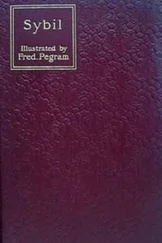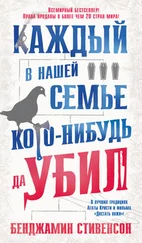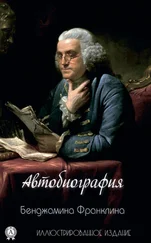The Immortalists by Chloe Benjamin

For my grandmother, Lee Krug
I am profoundly grateful for the many people who helped bring The Immortalists to life.
This book would not have been possible without the belief, labor, and advocacy of two incredible women. To my rock star and soul sister of an agent, Margaret Riley King: thank you for your faith, your loyalty, and your biweekly therapy sessions. Every time, it starts with you. To my editor, Sally Kim: your brilliance, passion, and integrity shine so brightly. Working with you has been one of the great honors, and pleasures, of my life.
I couldn’t have dreamed of more superb teams at WME and Putnam. It’s a privilege to work with Tracy Fisher, Erin Conroy, Erika Niven, Haley Heidemann, and Chelsea Drake at the former, and with Ivan Held, Danielle Dieterich, Christine Ball, Alexis Welby, Ashley McClay, Emily Ollis, and Katie McKee at Putnam, as well as the full Penguin team. My thanks, too, to Gail Berman, Dani Gorin, Joe Earley, and Rory Koslow at Jackal for their work in the TV arena.
I am indebted to the many writers, filmmakers, scientists, and other professionals whose work was pivotal to my research process. Essential sources include A subtle craft in several worlds: Performance and participation in Romani fortune-telling (Ruth Elaine Andersen); David Weissman’s documentary I Was Here ; Hiding the Elephant: How Magicians Invented the Impossible and Learned to Disappear (Jim Steinmeyer); and the life of Tiny Kline, a groundbreaking circus performer who originated the Jaws of Life and inspired the character of Klara Sr. ( Circus Queen and Tinker Bell: The Memoir of Tiny Kline , Janet M. David). Lt. Scott Gregory served as a crucial advisor for Daniel’s military career; Erika Flevry, Deborah Robbins, and Bob Ingersoll kindly shared their experiences with primates. The Drake was inspired by the Buck Institute for Research on Aging in Novato, California, though my version is, besides building features and general mission, entirely fictionalized. Finally, I couldn’t have written Varya’s section were it not for the many scientists whose longevity research informed her own, and who were so generous as to speak with me, including Drs. Ricki Colman, Stefano Piraino, and Daniel Martinez, as well as staff from the Wisconsin National Primate Research Center. Varya’s research emerged from this background but is, like the Drake, fictionalized and not meant as commentary on specific existing work.
Eternal love for, and thanks to, the family members and dear friends who served as early readers and offered assistance. My parents are my fiercest and most faithful supporters; I am so grateful, and so lucky, to be your child. My beloved grandmother and guiding light, Lee Krug, was the first person to read this novel. Among my brilliant friends, I am thankful for Alexandra Goldstein’s editing genius and lifelong devotion; Rebecca Dunham’s intellectual companionship; Brittany Cavallaro’s passionate solidarity; and Piyali Bhattacharya’s wise, beating heart, as well as the sisterhood of Alexandra Demet and the brotherhood of Andrew Kay. Marge Warren and Bob Benjamin gave me the gift of insight into immigrant and mid-twentieth-century life in New York City. Judy Mitchell continues to be a mentor and dear friend.
To Jordan and Gabriel, my siblings: this book is for you, too.
And, my God, what is there to say for Nathan? It isn’t easy to be the partner of a writer, but I would think you do it effortlessly if I didn’t know how much mind-bending conversation, editorial work, and emotional support it requires. You have the most abiding heart and the quickest brain and the kind of panoramic perspective that steadies even fluttery birds like me. Forever, thank you.
Prologue: The Woman on Hester Street
1969
Varya
Varya is thirteen.
New to her are three more inches of height and the dark patch of fur between her legs. Her breasts are palm sized, her nipples pink dimes. Her hair is waist length and medium brown – not the black of her brother Daniel’s or Simon’s lemon curls, not Klara’s glint of bronze. In the morning, she plaits it in two French braids; she likes the way they whisk her waist, like horses’ tails. Her tiny nose is no one’s, or so she thinks. By twenty, it will have risen to assume its full, hawkish majesty: her mother’s nose. But not yet.
They wind through the neighborhood, all four of them: Varya, the eldest; Daniel, eleven; Klara, nine; and Simon, seven. Daniel leads the way, taking them down Clinton to Delancey, turning left at Forsyth. They walk the perimeter of Sara D. Roosevelt Park, keeping to the shade beneath the trees. At night, the park turns rowdy, but on this Tuesday morning there are only a few clumps of young people sleeping off the previous weekend’s protests, their cheeks pressed to the grass.
At Hester, the siblings become quiet. Here they must pass Gold’s Tailor and Dressmaking, which their father owns, and though it is not likely he’ll see them – Saul works with total absorption, as if what he is sewing is not the hem of a men’s pant leg but the fabric of the universe – he is still a threat to the magic of this muggy July day and its precarious, trembling object, which they have come to Hester Street to find.
Though Simon is the youngest, he’s quick. He wears a pair of handed-down jean shorts from Daniel, which fit Daniel at the same age but sag around Simon’s narrow waist. In one hand, he carries a drawstring bag made of a chinoiserie fabric. Inside, dollar bills rustle and coins shimmy their tin music.
‘Where is this place?’ he asks.
‘I think it’s right here,’ Daniel says.
They look up at the old building – at the zigzag of the fire escapes and the dark, rectangular windows of the fifth floor, where the person they have come to see is said to reside.
‘How do we get inside?’ Varya asks.
It looks remarkably like their apartment building, except that it’s cream instead of brown, with five floors instead of seven.
‘I guess we ring the buzzer,’ Daniel says. ‘The buzzer for the fifth floor.’
‘Yeah,’ says Klara, ‘but which number?’
Daniel pulls a crumpled receipt out of his back pocket. When he looks up, his face is pink. ‘I’m not sure.’
‘Daniel!’ Varya leans against the wall of the building and flaps a hand in front of her face. It’s nearly ninety degrees, hot enough for her hairline to itch with sweat and her skirt to stick to her thighs.
‘Wait,’ Daniel says. ‘Let me think for a second.’
Simon sits down on the asphalt; the drawstring purse sags, like a jellyfish, between his legs. Klara pulls a piece of taffy from her pocket. Before she can unwrap it, the door to the building opens, and a young man walks out. He wears purple-tinged glasses and an unbuttoned paisley shirt.
He nods at the Golds. ‘You want in?’
‘Yes,’ says Daniel. ‘We do,’ and he is scrambling to his feet as the others follow him, he is walking inside and thanking the man with the purple glasses before the door shuts – Daniel, their fearless, half-inept leader whose idea this was.
He heard two boys talking last week while in line for the kosher Chinese at Shmulke Bernstein’s, where he intended to get one of the warm egg custard tarts he loves to eat even in the heat. The line was long, the fans whirring at top speed, so he had to lean forward to listen to the boys and what they said about the woman who had taken up temporary residence at the top of a building on Hester Street.
Читать дальше
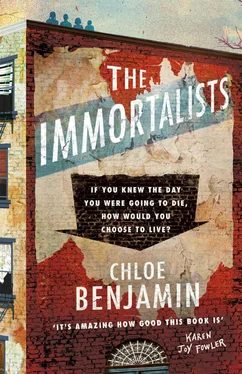


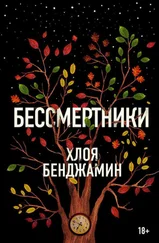


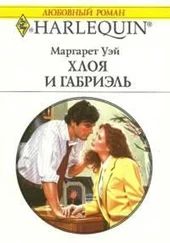
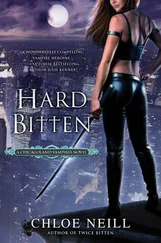

![Мелани Бенджамин - Госпожа отеля «Ритц» [litres]](/books/384861/melani-bendzhamin-gospozha-otelya-ritc-litres-thumb.webp)
